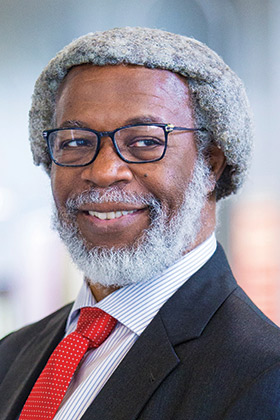A Bountiful Life: Jim Gates on the Role of Imagination in Physics
Fall
2021
Singularities - Profiles in Physics
A Bountiful Life: Jim Gates on the Role of Imagination in Physics
Korena Di Roma Howley, Contributing Editor
 The first hint that Jim Gates isn’t your average scientist—or even your average theoretical physicist, if such a person exists—is his characterization of physics not strictly as a field capable of answering the riddle of our universe but as one that also adds to our ability to live a bountiful life, in part by challenging us to exercise our minds as we do our bodies.
The first hint that Jim Gates isn’t your average scientist—or even your average theoretical physicist, if such a person exists—is his characterization of physics not strictly as a field capable of answering the riddle of our universe but as one that also adds to our ability to live a bountiful life, in part by challenging us to exercise our minds as we do our bodies.
As Gates speaks about his work, the power of the intuitive mind—its capacity for creativity and imagination—comes up frequently. He is quick to quote Albert Einstein, who famously said that imagination is more important than knowledge. And he expresses wonder at the role the subconscious mind plays in the eureka moments that have become ingrained in our collective vision of scientific breakthrough.
“When you’re a person like me who works in mathematics—the way that I know that it’s my imagination at work is because we have these so-called flashes of insight or intuition,” he says. “That is clearly coming to me from my subconscious.”
Born in Tampa, Florida, on December 15, 1950, Sylvester James Gates Jr. was only four when he saw a science fiction movie and sensed that science could provide a doorway to adventure. That perception proved true. Today, Gates is known for many things—his groundbreaking work in particle and mathematical physics, his appearances on the PBS series Nova, and his many accolades, including a National Medal of Science awarded by President Barack Obama in 2013.
But throughout his distinguished career, Gates has also remained a committed teacher, first at MIT, then at the University of Maryland, Howard University, and Brown University, among other institutions. He is also the current president of the American Physical Society. Along the way he has become a friend to SPS, participating in numerous events with SPS summer interns, graciously making time for student interviews, and speaking at the 2016 and 2019 Physics Congresses. After decades of working with students in both formal and informal roles, he continues to marvel at their capacity to offer fresh insights when looking at problems. For Gates, this ability among individuals demonstrates why the field of physics needs diversity—of background, of experience, of perspective. And, of course, it needs imagination. “Wider, more innovative, and robust forms come about when you allow the largest number of people to exercise their imagination,” he says.
His own career provides an example. Gates has spent more than 40 years working on supersymmetry—the theory that for every particle in the standard model, a partner particle exists. He first stumbled on the idea as a graduate student in the early 1970s, when the theory was only a few years old. He went on to author the first doctoral dissertation on the subject to be submitted at MIT. He now recalls how a willingness to explore a little-known topic more deeply enabled a single graduate student to stand out among the brilliant minds of the day. Many may credit personality, he says, “but my personality is formed out of culture, out of experience.”
Importantly in a field such as theoretical physics, Gates excels at presentations aimed at public understanding, at spinning narratives that elicit enthusiasm for and curiosity about concepts that often defy comprehension among nonphysicists. He frequently taps into the humanistic side of the discipline and illustrates his work in such a way that his audiences—whether students, conference goers, or television viewers—are left struck by the possibilities inherent in the field.
Gates believes that mathematicians and theoretical physicists should become proficient at using the language of mathematics to tell stories, transforming signs and symbols into narratives as novelists do words and sentences. “We don’t want to dazzle people with our ability to juggle arcane, strange symbols,” he says. “What we want to dazzle them with and invite them to be a part of—or at least understand the excitement of—is the stories behind the symbols.”
In recognition of his distinctive contributions to the field, the American Institute of Physics recently announced Gates as the recipient of its 2021 Andrew Gemant Award, bestowed for accomplishments related to the cultural, artistic, or humanistic dimension of physics. The award committee praised Gates for “instilling a deep and humanistic love of physics in generations of students, being a steadfast ambassador of science policy and the history of physics, and his persistent dedication to communicating the wonders of the field.”
When discussing the role of physics in history and culture, Gates goes again to Einstein. “If you look outside of his science, you’ll find that he had this enormous capacity to help others,” Gates says. It’s an ability he can surely relate to.
